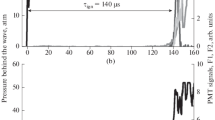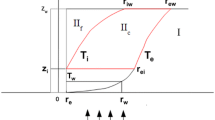Abstract
The course of explosions of propene/O2/N2 mixtures is determined for initial pressures of 1, 5, 10 and 30 bar abs and initial temperatures of 25 °C and 200 °C in a spherical vessel of 20 l. In the explosion triangle one can distinguish three different regimes where the combustion proceeds deflagrative, detonative and – in a narrow region inbetween these two regimes – in some transitional manner. What really happens in the transitional regime is not yet understood. Pressures turn out to be largest at the outer border of the detonative regime and not in it’s center. This is due to precompression of the yet unreacted mixture caused during the initial deflagrative stage of the combustion. Experiments performed in larger vessels up to 2.5 m3 indicate that these regimes do not vary too much with vessel volume. This observation can at least partly be explained by regarding the predetonation distances determined for these ternary mixtures in pipes as function of composition. Finally, an abundant set of explosion characteristics (explosion limits, deflagration pressure ratios, rates of pressure rise and combustion times) are determined.
Zusammenfassung
Der Explosionsverlauf von Propen/O2/N2-Gemischen ist bei Anfangsdrücken von 1, 5, 10 und 30 bar abs und Anfangstemperaturen von 25 und 200 °C in einem kugelförmigen Behälter mit 20 l Volumen bestimmt worden. Im Explosionsdreieck können hinsichtlich des Verbrennungsablaufes drei verschiedene Bereiche unterschieden werden, in denen die Verbrennung deflagrativ, detonativ und – in einem engen Mischungsgebiet zwischen diesen Bereichen – übergangsartig verläuft. Die Details des Verbrennungsablaufes im Übergangsbereich sind noch nicht verstanden. Die höchsten Drücke treten an der Außengrenze des detonativen Bereiches und nicht in seinem Zentrum auf. Dies ist eine Folge der während der anfänglichen deflagrativen Verbrennungsphase eintretenden Vorkompression des noch nicht abreagierten Gasgemisches. Untersuchungen in größeren Behältern bis 2.5 m3 deuten an, dass die verschiedenen Bereiche nur eine geringe Abhängigkeit vom Behältervolumen aufweisen. Diese Beobachtung ist zumindest teilweise erklärbar über die Detonationsanlaufstrecken, die Propen/O2/N2-Gemische in Rohrleitungen in Abhängigkeit von der Gemischzusammensetzung zeigen. Schließlich ist ein umfassender Satz an explosionstechnischen Kennzahlen (Explosionsgrenzen, Deflagrationsdruckverhältnisse, Druckanstiegsgeschwindigkeiten und Verbrennungszeiten) bestimmt worden.
Similar content being viewed by others
References
EN 13673-2 (2005) Determination of maximum explosion pressure and the maximum rate of pressure rise of gases and vapours, European Standard
Hattwig M, Steen H (eds) (2004) Handbook of Explosion Prevention and Protection. Wiley-VCH Verlag GmbH, Weinheim, ISBN 3-527-30718-4
EN 1839 (2003) Determination of explosion limits of gases and vapours, European Standard
National Institute of Standards and Technology (NIST) Standard Reference Database Number 69, June 2005 Release, http://webbook.nist/gov/chemistry/, accessed 2006
Russel FR, Mueller RH (1952) Chem Eng News 30:1239
Pekalski AA, Schildberg HP, Smallegange PSD, Lemkowitz SM, Zevenbergen JZ, Braithwaite M, Pasman HJ (2004) Loss Prevention and Safety Promotion in the Process Industries, 11th International Symposium, 31 May–3 June 2004, Praha, PG2118–PG2138
Public Deliverable no. 8 of the EU research project SAFEKINEX, 2003–2006, downloadable from website http://www.morechemistry.com/SAFEKINEX/deliverables.html, accessed 2009, “Report on the experimentally determined explosion limits, explosion pressures and rates of explosion pressure rise – Part 1: methane, hydrogen and propylene”
Public deliverable no. 9 of the EU research project SAFEKINEX: “Report on the experimentally determined explosion limits, explosion pressures and rates of explosion pressure rise – Part 2: ethane, ethylene, propane, n-butane, ammonia and carbon monoxide”
Public deliverable no. 10 of the EU research project SAFEKINEX: “Interpretation of gas explosion tests; extremes in explosion severity”
Public deliverable no. 13 of the EU research project SAFEKINEX: “Additional experiments”
Nettleton MA (1987) in: Gaseous Detonations, Chapman and Hall Ltd, New York, p 76
Vandebroek L, Van den Schnoor F, Verplaetsen F, Berghmans J, Winter H, van’t Oost E (2005) J Hazard Mater A 120:57–65
Shepherd JE (2006) Structural response of piping to internal gas detonation, in: Proceedings of PVP2006-ICPVT-11, ASME Pressure Vessel and Piping Division Conference, July 23–27 2006, Vancouver BC, Canada
Ginsburg I, Bulkley WL (1963) Chem Eng Progr 59(2):82–86
Bollinger LE, Fong MC, Edse R (1961) American Rocket Society: ASR Journal (Easton, PA) 31:588–595
Bollinger LE, Laughrey JA, Edse R (1962) American Rocket Society: ARS Journal (Easton, PA) 32:81–82
Author information
Authors and Affiliations
Corresponding author
Rights and permissions
About this article
Cite this article
Schildberg, HP. The course of the explosions of combustible/O2/N2 mixtures in vessel-like geometry . Forsch Ingenieurwes 73, 33–65 (2009). https://doi.org/10.1007/s10010-009-0091-6
Published:
Issue Date:
DOI: https://doi.org/10.1007/s10010-009-0091-6




